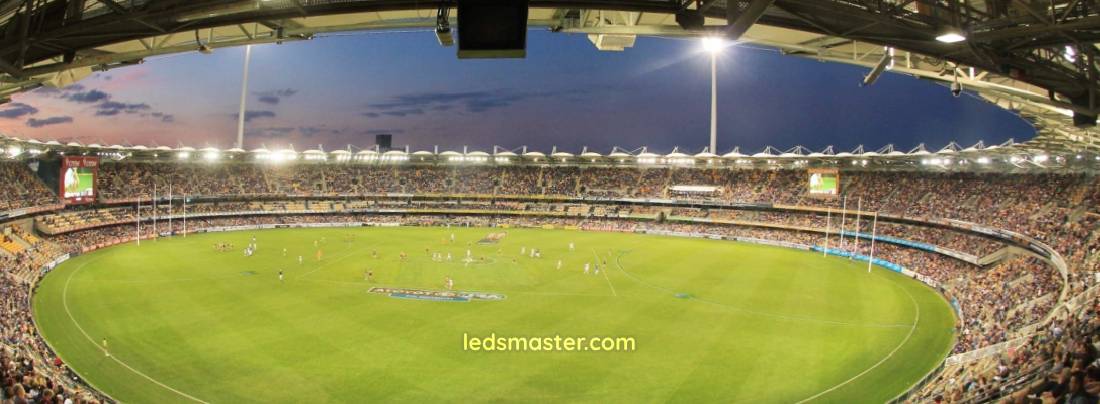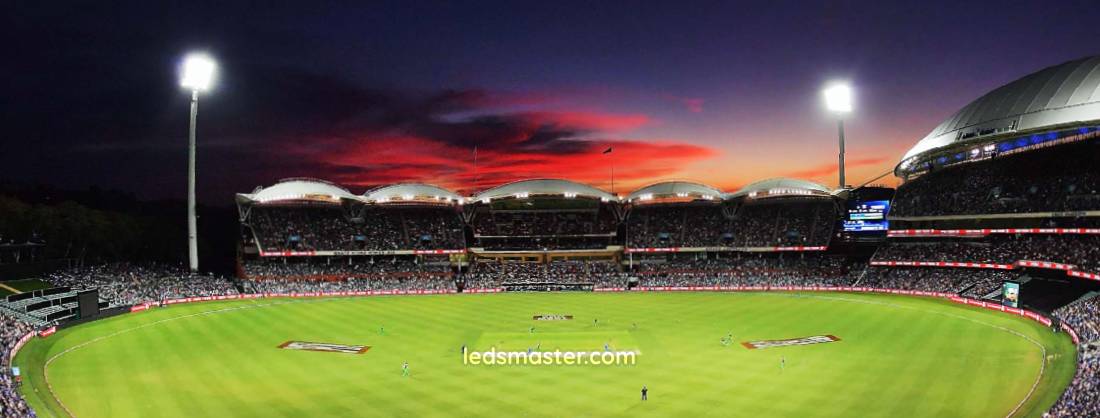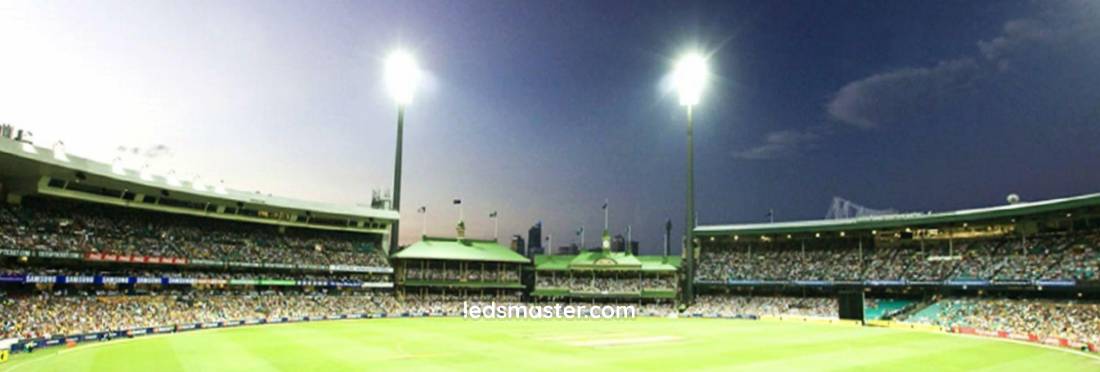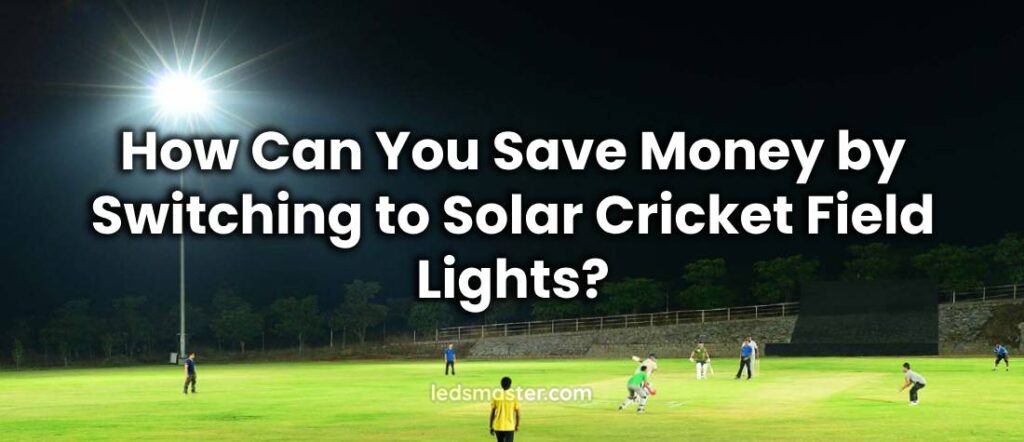When comparing solar and conventional lighting systems for cricket fields, the discussion often begins with upfront costs—but that’s only part of the picture. While traditional lighting may appear cheaper at the start, solar lighting offers long-term savings through zero energy bills, lower maintenance, and available government incentives. By examining both initial installation expenses and lifetime operational costs, it becomes clear that solar lighting can deliver greater value over time, especially for facilities aiming to reduce their total cost of ownership.
Table of Contents
ToggleCost Difference Between Solar and Conventional Lighting
Initial Investment vs Long-Term Value
| Cost Aspect | Solar Lighting | Conventional Lighting |
|---|---|---|
| Initial Installation Cost | $30,000 to $60,000 | $15,000 to $35,000 |
| Installation Labor & Material Savings | 30% to 50% less than conventional (due to no trenching/cabling) | Higher due to trenching, cabling, permits |
| Annual Energy Costs | $0 (free solar energy) | $5,000 to $10,000 |
| Fixture Wattage per Lamp | 100 to 200 watts (LED) | 400 to 1000 watts (metal halide/HPS) |
| Lamp Replacement Frequency | ~10+ years (50,000 hours LED lifespan) | Every 2 to 3 years |
| Lamp Replacement Cost | Minimal (rare replacements) | $100 to $300 per lamp plus labor |
| Maintenance Savings | Up to 40% less over lifespan | Higher maintenance and service costs |
| Battery Replacement Lifespan | 5 to 10 years | N/A (no batteries) |
| Government Subsidies & Incentives | 20% to 40% grants, up to 30% tax credits; $6,000 to $24,000 reduction possible | Rarely applicable |
| Total Long-Term Cost Consideration | Higher upfront, lower over 10–15 years due to no energy bills and reduced maintenance | Lower upfront but higher ongoing costs |
The upfront cost of installing solar-powered cricket field lighting is generally higher compared to traditional grid-connected lighting systems. For example, a complete solar lighting system for a standard cricket field can range from $30,000 to $60,000, depending on the size and technology used. In contrast, conventional lighting installation might cost between $15,000 and $35,000 initially. This difference is mainly due to solar systems requiring photovoltaic panels, inverters, and batteries, all of which contribute to higher capital expenditure.
Despite this higher initial price tag, solar lighting often results in lower overall costs over 10 to 15 years. Traditional lighting relies on electrical grid connections, which means ongoing utility bills can accumulate significantly—sometimes totaling $5,000 to $10,000 annually for energy alone, depending on usage and local electricity rates. These operational costs can surpass the initial installation price within a decade.
Installation of conventional lighting systems typically involves extensive groundwork, such as trenching for cables, electrical infrastructure setup, and permitting, which can add $5,000 to $10,000 or more to the project. By contrast, many solar lighting setups are self-contained, eliminating the need for trenching and extensive cabling. While poles and mounting hardware are still required, this often results in labor and material savings of around 30% to 50% compared to conventional installations.

Operational and Maintenance Expenses
Traditional lighting systems frequently use high-wattage lamps like metal halide or high-pressure sodium, which consume substantial energy—often between 400 to 1000 watts per fixture. Over time, the electricity costs for these lamps can reach $7,000 to $12,000 per year depending on usage hours and rates. Additionally, these lamps degrade, losing up to 30% of their brightness over 2 to 3 years, necessitating frequent replacements at costs of $100 to $300 per lamp, plus labor.
In contrast, solar lighting systems usually use LED technology, which consumes far less energy—often around 100 to 200 watts per fixture—and maintains performance for 50,000 hours or more, roughly translating to over a decade of use without replacement. Battery packs in solar setups now last around 5 to 10 years, with replacement costs decreasing as technology advances. Smart monitoring systems can notify operators of battery health, reducing unexpected failures and maintenance visits, which typically saves up to 40% in service expenses over the system’s lifespan.
Subsidies and Financial Incentives
Government programs play a significant role in offsetting solar lighting costs. In many regions, solar projects qualify for subsidies such as grants covering 20% to 40% of the initial investment, tax credits of up to 30%, or low-interest financing options. These incentives can reduce upfront costs by $6,000 to $24,000 on a typical solar cricket lighting system.
Conventional lighting projects rarely qualify for such benefits unless bundled into broader infrastructure efforts. Furthermore, incentives sometimes extend to reduced sales taxes on solar equipment or ongoing rebates based on energy savings, which can amount to several hundred dollars annually. This supportive financial framework makes solar lighting more affordable and attractive for cricket facilities seeking to balance upfront costs with long-term savings.
Why Can Solar Light Save Money?
Free Energy from the Sun
| Aspect | Solar Lighting | Conventional Lighting |
|---|---|---|
| Daily Electricity Generation | 5 to 10 kWh | N/A (uses grid power) |
| Lighting Hours Powered Daily | 6 to 8 hours | N/A |
| Electricity Cost Savings | $150 to $300+ per month (based on $0.10–$0.25 per kWh) | Pay $0.10 to $0.25 per kWh for grid electricity |
| Payback Period | 4 to 7 years (based on electricity savings) | N/A |
| LED Lifespan | 50,000 to 100,000 hours (5 to 10 times longer) | 5,000 to 10,000 hours |
| Maintenance Savings | Reduced due to longer lifespan and fewer replacements | Higher due to frequent replacements |
| Energy Use Reduction via Smart Controls | 30% to 50% reduction possible | Often no smart controls; runs at full brightness |
Once solar panels are installed and running, the electricity they produce is completely free and renewable. Unlike conventional lighting systems that rely on electricity from utility providers—where prices can fluctuate unpredictably—solar panels capture energy directly from sunlight without ongoing costs. This makes solar energy especially valuable in areas with abundant sunshine and long daylight hours, where the panels can generate substantial power throughout the year.
For example, a solar lighting system for a cricket field might generate 5 to 10 kilowatt-hours (kWh) of electricity daily, enough to power LED lights for 6 to 8 hours each evening without any electricity bill. Considering that commercial electricity rates can range from $0.10 to $0.25 per kWh, this translates to savings of $150 to $300 or more per month, depending on usage and local rates.
Solar cricket lighting systems operate independently of the electrical grid, which means that monthly power bills are eliminated entirely. Over time, the amount saved on electricity expenses can become quite substantial, often enough to offset the higher initial installation costs of solar equipment—typically recouped within 4 to 7 years. For venues hosting evening matches or training sessions regularly, these reductions in operating expenses provide a strong financial incentive to switch to solar-powered lighting.

Lower Wear and Tear on Equipment
Traditional lighting systems connected to the grid often experience voltage fluctuations and power surges, especially in rural or less-developed areas. These irregularities can cause damage to sensitive lighting components and shorten their effective lifespan. Solar lighting systems, however, function on a stable low-voltage platform powered by batteries, which helps avoid the stresses associated with grid power inconsistencies.
Because solar lighting commonly uses LED bulbs, the equipment operates at a lower temperature compared to conventional lamps. LED lights can last between 50,000 to 100,000 hours, which is roughly 5 to 10 times longer than metal halide or sodium vapor lamps that often require replacement every 5,000 to 10,000 hours. This reduction in heat exposure and longer lifespan contributes to a significant drop in maintenance and replacement costs.
As a result, the need for replacements and repairs is lowered, which reduces maintenance costs and downtime. Fewer part replacements mean less labor involved and fewer interruptions to cricket field schedules, contributing further to cost savings.
Smart Energy Management
Many modern solar lighting systems come equipped with smart controllers designed to optimize energy use. These systems often include features such as motion sensors, programmable dimming schedules, and remote monitoring capabilities. This technology allows operators to adjust lighting levels according to actual field use—dimming lights during warm-ups or practice sessions and boosting brightness during official matches.
By tailoring energy consumption to real-time needs, solar lighting can reduce power use by up to 30 to 50% compared to running lights at full brightness all the time. This energy efficiency reduces wear on equipment and extends the system’s useful life. Conventional lighting systems often lack these intelligent controls, requiring manual operation or running at full brightness for extended periods, leading to unnecessary energy use and higher costs.

Advantages of Solar Cricket Field Lighting
Energy Independence
One of the most appealing features of solar-powered lighting is the freedom it provides from reliance on the electrical grid. This advantage becomes especially valuable in locations where power supply may be inconsistent or completely unavailable. By tapping directly into sunlight, cricket fields can operate without worrying about interruptions caused by brownouts, blackouts, or voltage fluctuations. This independence ensures that games and practices can continue uninterrupted regardless of the local utility infrastructure.
Energy independence also offers a practical benefit for remote or temporary cricket fields, such as those set up for seasonal leagues, tournaments, or school competitions. Solar lighting systems are highly portable and require minimal fixed infrastructure, making it possible to install, dismantle, and relocate equipment quickly and with ease. This flexibility expands opportunities for outdoor sports in areas where permanent electrical setups might not be feasible.
Environmental Stewardship
Adopting solar lighting plays a direct role in reducing greenhouse gas emissions by cutting down on electricity generated from fossil fuels. Cricket grounds that use solar energy contribute to cleaner air and a smaller carbon footprint. This commitment to sustainability can enhance the reputation of sports organizations, attract sponsors who prioritize environmental responsibility, and foster goodwill within the local community.
Additionally, many solar lighting systems incorporate smart dimming and directional lighting features that minimize light pollution. By focusing illumination strictly where it is needed and limiting spillover into neighboring properties or natural habitats, these systems promote environmental protection while also improving playing conditions. The result is a lighting setup that supports both ecological health and the quality of the cricket experience.
Enhanced Safety and Reliability
Solar cricket lighting systems are built to operate autonomously and often include battery storage to maintain lighting during nighttime or cloudy conditions. This reliability ensures that evening matches benefit from consistent illumination, which improves player safety and enhances the experience for spectators. Knowing that lights will remain on regardless of grid failures provides peace of mind for event organizers and participants alike.
Because solar lights do not depend on external power sources, they are less vulnerable to weather-related disruptions or outages caused by local grid failures. The equipment is typically housed in sealed, weather-resistant enclosures that protect against rain, wind, dust, and other environmental factors. This rugged design reduces the likelihood of system breakdowns and extends the operational life of the lighting installation.
Customizable Designs for Different Field Layouts
Solar lighting systems offer greater installation flexibility compared to traditional lighting setups, which often require uniform pole spacing and extensive underground cabling. This flexibility allows solar lights to be positioned based on the specific shape and size of a cricket field. Whether illuminating a small community pitch, a school ground, or a professional stadium, solar systems can be tailored to meet varied lighting requirements.
Custom configurations help achieve more uniform lighting distribution and reduce dark spots, which enhances the quality of play and overall safety on the field. The modular nature of many solar lighting products makes it easier to upgrade or expand the system over time. This adaptability means fields can adjust their lighting as demands change, without needing major rewiring or costly reconstruction.
Long-Term Value for Sports Facilities
Many cricket clubs, schools, municipalities, and private operators manage their resources carefully. Solar cricket field lighting offers an opportunity to turn a single investment into years of low operating costs. Savings come not only from energy reduction but also from decreased maintenance and fewer lighting replacements.
As energy costs continue to rise and technology advances, the financial advantages of solar lighting are expected to become even more compelling. Systems installed today can often be updated with new batteries, more efficient solar panels, or enhanced smart controls without needing a complete overhaul. This means facilities benefit from ongoing improvements in performance and savings long after the initial installation.
Final Thoughts
Switching to solar lighting for cricket fields brings together multiple advantages that directly affect cost-saving outcomes. From the elimination of monthly power bills to the reduction in maintenance and equipment failure, solar systems demonstrate a compelling financial logic. By choosing solar, operators also reduce their exposure to rising energy prices and infrastructure dependencies, creating a more predictable and manageable operating environment.
Cricket fields of all sizes stand to benefit, whether they host professional matches or community games. The blend of sustainable energy, modern control systems, and long-term reliability offers a lighting solution that meets both financial and functional expectations. As technology becomes more accessible and awareness grows, solar cricket field lighting is positioned to become a preferred choice for those aiming to reduce costs while maintaining high-quality performance.

